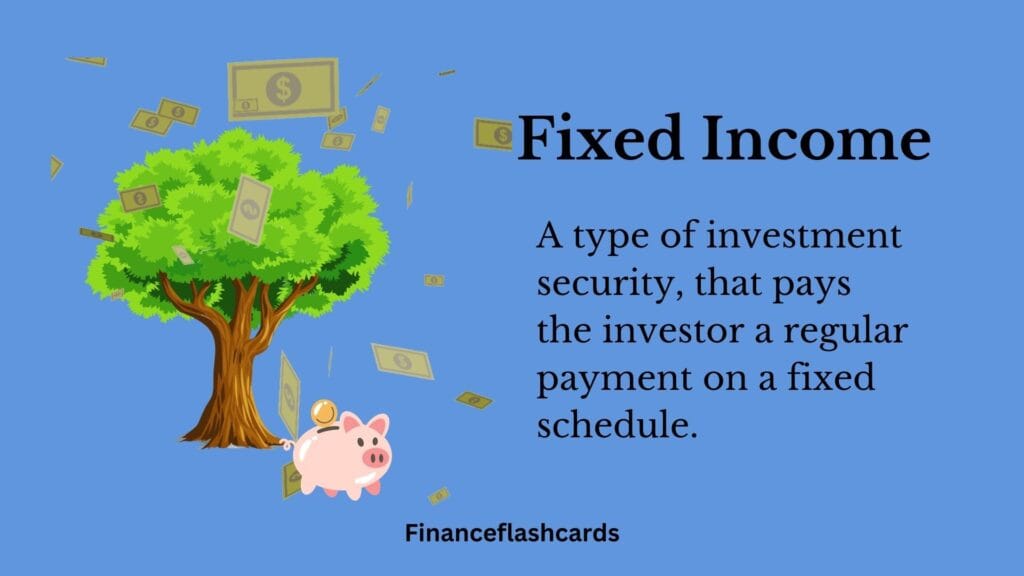Fixed Income refers to investments, like bonds, that provide regular interest payments and return the principal at maturity, offering stable and predictable income with lower risk than equities.
Table of Contents
What is Fixed Income
Fixed income is a type of investment that makes regular, predictable payments, usually in the form of interest, until maturity, when the principal amount is returned to the investor. These investments are generally considered less risky than equities, making them appealing to income-seeking or risk-averse investors.
The most common fixed-income products are government and corporate bonds and in the event of a company’s bankruptcy, fixed-income investors are typically paid before common stockholders.

Understanding Fixed Income
Companies issue bonds to raise funds for expansion, refinancing debt, or managing operational costs without diluting ownership.
Governments issue bonds to finance public projects, manage budget deficits, or regulate the economy. Bonds provide a cost-effective way to secure long-term capital while offering investors a predictable return through interest payments and principal repayment at maturity.
For example
A company may issue an 8% bond with a $1,000 face or par value that matures in five years. The investor purchases the bond for $1,000, which will not be repaid until the end of five years. Over the course of five years, the company makes interest payments (known as coupon payments) at an annual rate of 8%.
As a result, the investor receives $80 annually for five years. At the end of five years (on the maturity date), the investor receives the $1,000 they initially invested.
As a result, the investor receives $80 annually for five years. At the end of five years (on the maturity date), the investor receives the $1,000 they initially invested.
Types of Fixed Income Products
As stated earlier, The most common fixed-income products are government and corporate bonds however there are other different types of fixed assets.
- Government Bonds: Issued by national governments (e.g., U.S. Treasury bonds), they are considered low-risk investments. They provide regular interest payments and return the principal at maturity.
- Corporate Bonds: Issued by companies to raise capital for business activities. They offer higher yields than government bonds but come with more risk based on the company’s creditworthiness.
- Municipal Bonds: Issued by state or local governments to finance public projects like schools or infrastructure. These bonds are often tax-exempt.
- Certificates of Deposit (CDs): Offered by banks with fixed interest rates and maturities. They are low-risk but lock your capital for a specific period.
- Fixed Income Mutual Funds/ETFs: These pooled investment funds invest in a range of fixed-income securities. They offer diversification and are actively or passively managed.
- Inflation-Linked Bonds: Bonds like U.S. TIPS (Treasury Inflation-Protected Securities) where the principal is adjusted for inflation, providing protection against rising prices.
Fun Fact
The first recorded bond issuance was in 1693, when the British government issued bonds to fund a war with France. Bonds have been crucial in financing since then!
Fixed Income Investments Are Ideal For
For investors who are looking for stability, predictable returns, and less risk than stocks, fixed income investments are perfect.
They are particularly beneficial for retirees who need a steady income to cover living costs. Fixed income products are also advantageous to income seekers, such as those seeking steady cash flow.
Furthermore, fixed income is essential for balancing risk in diversified portfolios. All things considered, they draw risk-averse people who value capital preservation over large returns, providing a safer alternative for investments in volatile markets.
They are particularly beneficial for retirees who need a steady income to cover living costs. Fixed income products are also advantageous to income seekers, such as those seeking steady cash flow.
Furthermore, fixed income is essential for balancing risk in diversified portfolios. All things considered, they draw risk-averse people who value capital preservation over large returns, providing a safer alternative for investments in volatile markets.
Advantages and Disadvantages of Fixed Income
Advantages of Fixed Income
- Predictable Income: Provides regular interest payments, making it ideal for income-seeking investors.
- Lower Risk: Generally considered less volatile than equities, offering a safer investment option.
- Capital Preservation: Offers a return of principal at maturity, making it a good choice for risk-averse investors.
- Diversification: Helps balance the risk in a diversified investment portfolio, reducing overall volatility.
- Tax Benefits: Some fixed-income products, like municipal bonds, offer tax-exempt interest income.
Disadvantages of Fixed Income
- Lower Returns: Compared to stocks, fixed income generally offers lower returns, especially in a low-interest-rate environment.
- Interest Rate Risk: When interest rates rise, the value of existing bonds falls, potentially leading to losses if sold before maturity.
- Inflation Risk: Fixed payments may lose purchasing power over time if inflation outpaces the bond’s return.
- Credit Risk: Issuers may default on interest payments or fail to repay the principal, particularly with lower-quality bonds.
- Liquidity Risk: Some fixed-income products may be harder to sell or have wider bid-ask spreads, leading to potential difficulties in liquidation.
Crucial Information
Treasury Inflation-Protected Securities (TIPS) are one type of government bond that protects investors by being indexed to changes in the inflation rate.
Final Thoughts
The term “fixed income” describes both the principal return and the fixed interest rate paid by debt securities. Bonds and certificates of deposit are examples of fixed-income securities.
As an asset class, fixed income is thought to be more conservative and typically less volatile than stocks. Fixed income should make up a portion of a well-diversified portfolio. As their investment time horizon gets shorter (for example, as retirement draws near), this allocation rises for certain investors.

















